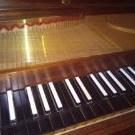All Activity
- Past hour
-
Morning @Thatguy v2.0 Here is mine review of the prelude: The overall structure is built is first on opening phrase. I love how you use this idea and expand on it. The anticipation of each chord of each phrase is nice resolution of the chromatic raising line. I think the implied harmonies: I-V/V-bII6-I. This now makes ask...why are we going from V/V to bII6? 🙂 The answer: this is not a typical resoultion of the seconary dom...
-
.thumb.png.1e2763f479362bbb522da50d31ef2e50.png)
Scrolling Score Finale videos
therealAJGS replied to Kvothe's topic in Music Notation Software Help and Discussion
are you looking for free editing software's or good ones? -
therealAJGS started following Scrolling Score Finale videos
-

Is Video Game Music Declining In Popularity?
Thatguy v2.0 replied to AngelCityOutlaw's topic in Composers' Headquarters
This is great news, I've sorta distanced myself from film music because of all the rah rah storm drum samey rhythmic drivel. I know there's more out there though, I just don't know it. Any film composers you (or anyone) are impressed with lately? - Today
-
Awesome Henry! I have a version with all the fingering if that helps 😛
-
I guess it should really be Benediction OF PJP II, not for, but I guess my setting is a Benediction For!😃
-
If I have to delete and republish this thing to correct two notes... Maybe by the end of the century, Noteflight can get around to updating a two-note edit!🤣 FINALLY!!!😃
-
OK, words in in the soprano part. There is an entry mistake in the soprano part, early on, but Noteflight is having particular trouble changing two notes this lovely morning!😆 (Measure 6 beat four, C#, measure 7 beat one, D.) I've tried to get it to save half a dozen times, could try again in a bit: someone must be on vacation at Noteflight, or maybe the whole company...
-
PeterthePapercomPoser started following fur elise orchestrated and Scrolling Score Finale videos
-
.thumb.png.8b5b433a341551e913a34392660bc95b.png)
fur elise orchestrated
PeterthePapercomPoser replied to Tunndy's topic in Piano Music, Solo Keyboard
Hey @Tunndy! Although I don't think that this orchestration is entirely in good taste (with some parts still sounding quite mechanical and robotic such as especially the triplet 16th note runs) I think it's a huge improvement over your other orchestrations of famous piano pieces! You didn't include the piano in the orchestration as a crutch, and you use the instruments mostly idiomatically, making good solo instrument choices and giving the different instruments a chance to imitate each other creating changes in timbre that were original and most definitely not intended in the original. I like how you let the solo flute lead with the main melody, using the strings at first only to outline the harmony. Later you include some variations on the main melody to extend it. Then you include harp arpeggios in a way that sounds appropriate to a harp rather than a piano. You also create lots of variation and contrasts between restatements of the melody that in the original were the same. I like your use of dynamics and thickening up of the texture and creation of dramatic moments with the timpani. All in all, I think this was a very successful orchestration! (despite some things I would have excluded) Great job and thanks for sharing!- 1 reply
-
- 1
-

- Yesterday
-
Is Video Game Music Declining In Popularity?
AngelCityOutlaw replied to AngelCityOutlaw's topic in Composers' Headquarters
I do think the pendulum is finally swinging back. I was at a film festival last weekend and talking with the producer of a film I'm currently scoring and a director it was interesting. The producer was talking about how most all of the films at the festival would have ambient scores. We were all talking then about John Williams, Goldmsith, etc. and my work and then the guy had this pained look in his eyes, shook his head and said "...I just love orchestral scores." I think the new generation of film makers are into melodic orchestral scores, but there's not many people making them and doing it well. I'm basically the only one in my area. Film and game makers can only work with what's on offer. But I don't expect the Zimmerites of the world, especially those making a lot of money, to allow that pendulum to swing without a serious fight. -
Fruit hunter started following Birthday waltz and Symphonic fantasies
-
I’ll just be looking at eight crows in a tree today just the title already makes it sound like a dark but light piece. Kind of like that beginning it’s more monophonic than anything else, but it sounds good though. kind of like the imitation from the winds to sound like crows. I don’t know if that’s intentional, but that was a good effect though. It kind of feels empty, but the effect of it being empty makes the piece like hollow in a sort of sense. OK, I like the harmonic development that’s going on. Around the three minute mark. Nice percussion feature. I do see the use of the Octotonic scale. Great ending with that chord. OK in terms of development I get this style is supposed to be free flowing which is achieved in a good manner and is done effectively. It really takes a good year and some getting used to to go with the flow of this piece. Anyways, good job keep it up.
-
Wow, that beginning is very serene. I love this harmonic content. It’s giving off already. OK, I love the layering with this with the themes. Make sure you give the double bass something to play. I like the re-entering of the main theme later on that is a really nice touch. I think the recording shut off at three minutes. I don’t know if it’s supposed to go longer, but if that’s the end, it feels unfinished. anyways, good job with this I really love the feel and style you’re going through
-
Hey gang, I have a important question (and this for finale or dorico users) what do you use to make You tube videos?
-
Lohena joined the community
-

Concerto in C for Flute and Orchestra
Kvothe replied to J. Lee Graham's topic in Orchestral and Large Ensemble
How do you capture the score? -

2025 Halloween Satisfaction Survey
Kvothe replied to PeterthePapercomPoser's topic in Monthly Competitions
You can still write and submit for feedback. 🙂 -
Tunndy started following fur elise orchestrated
-
umfr.pdf fur-elise-beethoven.mp3
- 1 reply
-
- 1
-

-
Yeah William Byrd's music is so colorful! The false relation in English Renaissance is very espressive. And I always like how Dufay is influenced by Dunstable with all the uses of 3rds and Faxbourdon texture. Basically the English are the one who pushes the history forward from the era of octaves and fifths to thirds by moving that overtone series one step further. Henry
-
thanks @Henry Ng Tsz Kiu - yeah, English renaissance was very colorful and actually had a pretty big range of expression from the silly character pieces to some of the serious monoliths. Sometimes I get upset that I discovered it so late.
-

piano Is my Piano Prelude any good? (Recorded Performance)
Mooravioli replied to Mooravioli's topic in Piano Music, Solo Keyboard
-

piano Is my Piano Prelude any good? (Recorded Performance)
Mooravioli replied to Mooravioli's topic in Piano Music, Solo Keyboard
Brotha Henry, Thank you truly for your kind comment. You have definitely helped me during it's compositional process, but in regards to the length of the piece, I have actually shortened it as opposed to adding on. Especially in the trio, I feel the material has become more concise and easy to digest. I've never even noticed the counterpoint in the G sharp minor section, does that mean I am now prepared to write a 6-part fugue in a krabby canon style? For the recapitulation, I needed something that will segue nicely into the original tempo, and that means slowly increasing speed using the offbeat figure. Thanks for commenting, as always. -
I've always prioritized voice leading in my chord construction; sometimes, I just slap a root on there and it works out! Thank you both for listening!
-

I wrote some variations on Dies Irae for string quartet
Monarcheon replied to 林家興's topic in Chamber Music
As a cellist, I personally like seeing the downwards arpeggio line, but I suspect Scriabin wrote it the way he did because he wanted to specify that the root(?) occurred on the beat. I see both having merit in different cases, but—generally—the arp. line is probably fine. -
PeterthePapercomPoser started following It was a dream (attemp at cinematic composition)




